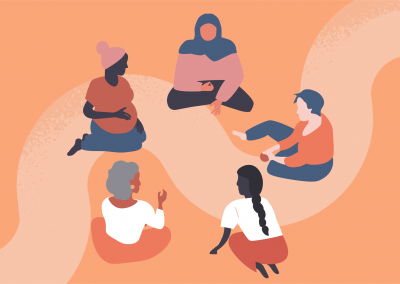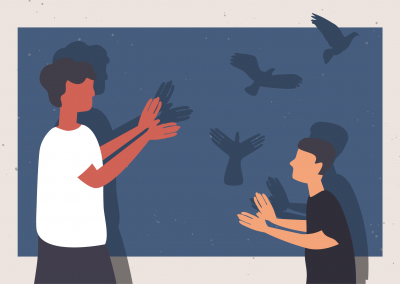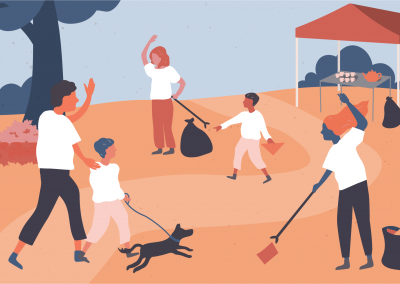Barking and Dagenham Children’s Social Services
Returning social care to its radical, relational roots
Case Maker –> Stories –> Barking and Dagenham Children’s Social Services
Radical. Disruptive. Activist.
These may not be words we associate with local council employees. And yet, they’re central to Barking & Dagenham’s relational approach to social care. ‘Social work has radical, relational roots’, says Russ Bellenie, their Principal Social Worker. ‘We’ve lost that. We’ve become public officials. We need to get back to those roots.’
In some ways social work is intrinsically relational. ‘Who else goes into your house and asks such intense questions?’ Russ asks. But having the right to ask intimate questions is not the same as having a relationship that allows you to ‘be a catalyst for change in a child’s life’. There is a very visible power dynamic to social work. When a social worker visits, families may be frightened, uncomfortable or deferential, hostile, suspicious or withdrawn. They may have no desire to engage. Social workers may find themselves knocking on a closed door.
Trusting relationships matter. They are not just a backdrop to good social work. They are, Russ says, ‘a mechanism by which change is achieved’. They don’t just enable other interventions, ‘the relationship is the intervention.’
Thinking like an activist
This is where being an activist comes in. Activists have a sense of agency; they believe they can have an impact in situations where people might give up. Barking & Dagenham ask their social workers to think like activists: to be creative and take responsibility for their practice, to look at each situation with fresh eyes rather than seeking comfort and familiarity in systems and formulae.
But is it realistic to expect social workers to bring an activist approach to a role with such high pressure and high risks?
Barking & Dagenham realise that one of the greatest risks they face is social work conducted without a relational approach. ‘If you’re too bureaucratic and too formulaic,’ Russ says, ‘if you ask closed questions and act like a rigid public official, no one is going to work with you.’
The pressure, the risks, the workload can lead to unambitious, box-ticking forms of social work – dissatisfying for social workers and families alike. Barking & Dagenham’s relational approach is embedded in its new CARES framework, which explains how Children’ Social Care practitioners are expected to work with children and families, and what they can expect from the council in return. ‘It aims to put the heart back into social work practice,’ says Russ, ‘and publicise that in Barking & Dagenham, social work cares, is innovative, collaborative, and hopeful.’
The focus on relationships is pragmatic as well as radical: better relationships lead to better outcomes, more rewarding work, and more manageable workloads.
Hopeful disruption
How does a new approach like this take root? How do you spread and embed radical, relational practice across the stratified structures of a large council department?
To shift mindsets and support their teams to think and work creatively, Barking & Dagenham have placed artistic and cultural practices at the heart of their work, through the New Town Culture programme: an internal catalyst for disruption and imagination.
New Town Culture trains and supports the council’s social workers to take a more creative, relational approach. Central to this is cultivating ‘hopeful disruption’: the willingness to take risks and disrupt norms in order to create possibilities for meaningful connection.
A big part of a social worker’s job is getting information from young people. But as social workers know, sitting in an office, staring at a young person, with a pen poised above a notepad, tends not to be the best way to do that. In this situation, says Marijke Steedman of New Town Culture, hopeful disruption could take the form of drawing with a young person, or listening to music and taking turns to pick songs. It could involve a social worker deliberately swearing in a chat with a 17-year-old, to signal that she’s lowering the level of formality. It might involve going for a walk with a young person and inviting them to choose the route.
Hopeful disruptions challenge expectations about what can happen in a social work space. They may not look like much, but they ‘shift some boundaries’, says Marijke, ‘and shift the transactional nature of the situation’.
Take listening to songs together. It’s not risky, but it enables connection around something personal. A young person can get to know their social worker better. And songs that are important for young people can lead to important stories from their lives.
‘Many social workers do this intuitively’, Marijke says. The idea of ‘hopeful disruption’ gives language to an area of relational practice that might otherwise be under-appreciated or left to chance.
Breakthroughs in relationships
Russ gives the example of a social worker who was having a difficult time building a relationship with a young person. They saw that the young person’s favourite band was due to play a gig in London and arranged for them to go and see it. Inviting that young person to the gig, sharing that moment of connection, was a breakthrough in that relationship and enabled the work that needed to happen.
This story falls somewhere between heartwarming and alarming. Should every social worker take children to expensive events outside normal working hours? Is that sustainable, affordable, appropriate?
A disruptive, activist approach involves spotting creative opportunities for meaningful engagement, even if they seem unexpected. In this instance, the social worker sensed that this could be a way to build trust with a young person who had strongly resisted the relationship. They did a risk assessment, a special budget was granted, the Head of Service signed off on it. What this situation demonstrates is an ethos where this kind of unexpected move is possible and welcomed.
Sharing power
Taking a radical relational approach doesn’t mean there are no boundaries. Ultimately it’s about recognising that social work is a collaboration, not a unilateral process.
‘Families say what annoys them is social workers being secretive’, Russ says. ‘They turn up to hearings and they don’t know what’s going to be shared.’
Young people and families need to co-produce and own the plan for their situation. Being secretive and non-collaborative is a way for social workers to hold onto power. ‘You have to name the power as soon as you get there’, Russ says, and share it with families, ‘or the relationship may struggle to get off the ground.’
Relational work at scale
How do you build a team of social workers with a relational approach?
Part of it is hiring based on relational values. Part of it is making the approach really explicit – ‘being granular about things that people aren’t always granular about’ – and providing tools, training, shadowing, modelling and coaching.
Instead of leaving the skills and techniques of relational work to chance, or treating them as something mysterious, Barking & Dagenham make them visible and explicit, teaching and sharing them at scale, embedding them into the heart of their practice. Social workers know this is what’s expected and what their managers will be looking for.
Forging, and working through, relationships is treated as a learnable, coachable skillset, at which everyone can continuously improve.
Even after putting relationships at the heart of recruitment, training and mentoring, there can still be challenges. Social workers ‘have to choose to work in this way,’ Russ says. There are occasions where a social worker doesn’t buy in and their work appears ‘stilted and rigid’, potentially leaving families feeling ‘done to’.
Even when there is an organisation-level commitment to transformation, even when leaders have their hands on all the levers, it takes time to overcome entrenched habits and mindsets, and to recalibrate culture, norms, policies and procedures across a system.
Team around the relationship
Barking & Dagenham children’s services are a striking example of an institution who have to work at scale (social care accounts for over 75% of the council’s budget) but are committed to relating to the many people they support as individuals, not ‘cases’.
‘No one wants to be a case’, says Russ. ‘Language like that can shut down relationships.’ The care Barking & Dagenham take over their language, another major feature of their CARES framework, is indicative of the way their relational approach flows through their formal structures. Social workers don’t arrange for children to ‘have contact with their family’, they arrange ‘family time’. After a visit, instead of sending ‘case notes’ describing what they saw, social workers write a letter to the family. When social workers conclude their work with a family they no longer talk about ‘closures’. ‘Now we call it a goodbye,’ Russ says. ‘A closure feels so formal and cold.’
Institutions are often associated with coldness and formality. Barking & Dagenham are trying to disrupt these expectations. ‘Have you heard of team around the child?’ Russ asks. ‘Instead we talk about team around the relationship.’
It’s a small change of wording, but it conjures a completely different image. It’s another step towards making a large social institution radically relational.
Reflection questions
Digging deeper
- What difference does investing in relationships make in this example?
- What barriers and challenges need navigating to work relationally in a statutory context?
- What does safeguarding look like in relational work?
Applying the learning
- What form could ‘hopeful disruption’ take in your context?
- What measures could you put in place to ensure that relational work is done safely?
More stories
The Relationships Map
The Relationships Map is a space for anyone who believes in the importance of relationships to find one another, share ideas and resources, feel part of something bigger, and realise more than the sum of our parts.









